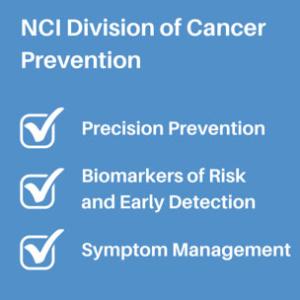Date Posted, by Philip E. Castle, Ph.D., M.P.H.

A year ago, I said that coming on board as the Division of Cancer Prevention Director in July 2020 was a “challenge,” adding that I had faith in science that the pandemic would be solved soon. Science has brought us a vaccine against SARS-CoV-2 and medicine to treat the disease, but we still aren’t all together in the workspace or many other places. We all look forward to that day.
Despite the challenges that continue to keep us physically apart, I think we are philosophically together in our desire to prevent cancer. Our mission hasn’t changed, and our motivation hasn’t changed. We even updated our Division mission statement to make our intentions clear:
The Division of Cancer Prevention furthers the mission of the National Cancer Institute by leading, supporting, and promoting rigorous, innovative research and training to prevent cancer and its consequences to improve the health of all people.
We are innovating and striving to prevent both cancer and the inequities that accompany it, and I believe the past year has shown that cancer prevention, detection, and supportive care research is hard at work, pushing the bar forward.
This past year, we had key, DCP-supported scientific advances published including:
- A study of naproxen as a promising strategy for immune interception in people with hereditary non-polyposis colon cancer. The drug induced immune-modulation and made structural changes in key tissues of the intestine. Naproxen-induced gene expression profiles can also potentially be used as biomarkers to predict if other medicines might prevent cancer.
- Patients with a history of colon adenomas were vaccinated with a MUC1 peptide vaccine to elicit immunity to the protein being expressed in adenomas, with a goal of preventing adenoma recurrence. Those vaccinated developed an immune response, and follow up colonoscopies showed a lower rate of polyps compared to unvaccinated patients.
- Early data from a study of a delayed booster for HPV vaccination was submitted to the World Health Organization (WHO), leading to a recommendation from the WHO that the second HPV shot (the booster) could be delayed as long as 3 to 5 years.
This coming year promises even more great science. Overall, we have three broad areas we want to focus on now, and in the future. One is identifying “druggable” targets for preventive drugs and developing the drugs. To that end, we have launched new projects and programs:
- The Cancer Prevention-Interception Targeted Agent Discovery Program is a collaborative research network with the overarching goal of discovering molecularly or immunologically targeted agents designed to prevent or intercept the oncogenic process in higher-risk populations. RFAs are open through October 8 to be part of this network.
- The Cancer Prevention Clinical Trials Network gained two new members and began development of multiple phase 0-II clinical trials to bridge the gap between preclinical agent development and phase III efficacy trials. The goal is to understand mechanisms driving or restraining precancers and early cancer, and use this knowledge in precision prevention.
- The US-Latin American-Caribbean HIV/HPV-Cancer Prevention Clinical Trials Network was launched, forming an international collaborative research network to improve and optimize prevention of HPV-related cancers in people living with HIV infection.
- The HIV/Cervical Cancer Prevention “CASCADE” Clinical Trials Network funding announcement will open soon. The CASCADE Network seeks to conduct pragmatic clinical trials evaluating the effectiveness of clinically proven interventions to overcome barriers and reduce failures in the cervical cancer screening, management, and precancer treatment cascade for women living with HIV.
Next are biomarkers of cancer risk: we need to know in a definable way, who is at risk for cancer and how strong is that risk? We want to combine the knowledge of this risk, with an appropriate agent to reduce the risk based on what we know about the individual. Projects in these areas include:

DCP Director, Philip E. Castle, Ph.D., M.P.H.
- Three pilot projects focused on Traceback Testing, the identification and genetic counseling of mutation carriers through family-based outreach, began this year. These grants address the necessary ethical, legal, and societal implications related to this process.
- Translational and Basic Science Research in Early Lesions is an open funding opportunity to fund research centers to integrate basic and translational cancer research studies to examine the direct causal relationships and interactions of early lesions, their microenvironment, and host-systemic factors. RFAs are open through November 2, 2021.
- Ongoing projects in biomarkers and detections have been renewed with new funding opportunities, including the Consortium for Imaging and Biomarkers and the Pancreatic Cancer Detection Consortium.
- The Early Detection Research Network reached a milestone of 20 years researching biomarkers for detecting cancer and cancer risk in 2020. A special FOCUS section of the December 2020 issue of Cancer Epidemiology, Prevention, and Biomarkers had articles about the progress achieved by the network. NCI Director Ned Sharpless, M.D., and I joined other investigators in lauding this work in a blog from the American Association of Cancer Research. Best of all, the EDRN will continue with a renewal for which applications were accepted until last week.
- We are also actively discussing how new multi-cancer early detection (MCED) tests might benefit the public, because screening for multiple cancers simultaneously poses many uncertainties. The gold standard for demonstrating benefit is a clinical trial that demonstrates the test reduces the chance of dying from cancer. A large trial is needed, and we need to consider how it should be carried out. So stay tuned for more on that topic.
Finally, we need to improve symptom management in those with cancer who are in treatment. While it is a long-standing part of the division’s portfolio, Division of Cancer Prevention is a name that does not suggest we have symptom management in our portfolio. Yet, we need to better understand the biology behind a person’s symptoms due to cancer, and their response to treatment–bringing better care to most vulnerable, cancer patients. To that end, we support a number of funding opportunities to answer a wide range of critical questions, including:
- Clinical Characterization of Cancer Therapy-induced Adverse Sequelae and Mechanism-based Interventional Strategies to support collaborative research projects designed to address adverse sequelae of cancer therapies that persist and become chronic comorbidities or develop as delayed posttreatment effects.
- Improving Outcomes in Cancer Treatment-Related Cardiotoxicity encourages collaborative applications that will contribute to the identification and characterization of patients at risk of developing cancer treatment-related cardiotoxicity. The primary intent is to mitigate cardiovascular dysfunction while optimizing cancer outcomes.
- Mechanisms Underlying the Contribution of Sleep Disturbances to Pain encourages mechanistic research to investigate the impact of sleep disturbances on pain. The mechanisms and processes underlying the contribution of sleep and sleep disturbances to pain perception and the development and maintenance of chronic pain may be very broad, so interdisciplinary work is urged.
- Music and Health: Understanding and Developing Music Medicine seeks to increase our understanding of how music affects the brain when it is used therapeutically and/or use that knowledge to better develop evidence-based music interventions to enhance health or treat specific diseases and disorders.
As I have said recently in an editorial in STAT, cancer prevention uses the same tools that are being used effectively to combat COVID-19: avoidance, screening and treatment, and vaccination. Many of the challenges we face in dealing with COVID are the same as those we face with preventing cancer.
Every year 1.8 million Americans get diagnosed with cancer and 0.6 million Americans die from cancer; globally, there are 18 million cancers and 9 million related deaths annually. We must renew our efforts to develop new and better cancer prevention and symptom management strategies, anchored in the best science and demonstrated through evidentiary research, which work for and reach all Americans and people globally. Although the challenges are great, the rewards are even greater.
If you would like to reproduce some or all of this content, see Reuse of NCI Information for guidance about copyright and permissions. Please credit the National Cancer Institute as the source and link directly to the blog post using the original title, for example: "A Message from the Director: A Year of Making the Cancer Prevention Intention Clear was originally published by the National Cancer Institute." For questions, contact us at CancerPreventionBlog@mail.nih.gov.
